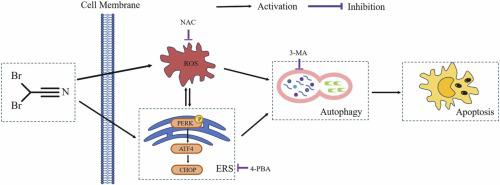Toxicology ( IF 4.8 ) Pub Date : 2023-12-06 , DOI: 10.1016/j.tox.2023.153698 Fang Li 1 , Xueyu Zhu 2 , Xinwei Xu 1 , Jie Zhou 3 , Rongzhu Lu 1 , Suhua Wang 1 , Guangwei Xing 1 , Yang Ye 1

|
Dibromoacetonitrile (DBAN) is a high-risk haloacetonitrile (HAN) generated as a byproduct of chloramine disinfection in drinking water. DBAN-induced neurotoxicity in mouse hippocampal neuronal cells (HT22) and mammals was observed to be related to reactive oxygen species (ROS). ROS, endoplasmic reticulum stress (ERS) and autophagy play crucial roles in regulating a variety of cellular processes. However, whether ERS and autophagy are associated with HAN-responsive apoptosis remains unclear. This study indicated that DBAN (10 μM, 24 h) activated the ERS protein kinase like endoplasmic reticulum kinase (PERK) signaling pathway. The ERS inhibitor 4-phenylbutyric acid (4-PBA) reversed DBAN-inhibited cell viability and alleviated DBAN-induced apoptosis in HT22 cell, indicating that activation of the ERS PERK pathway mediates DBAN induced cytotoxicity. Moreover, DBAN activated autophagy. The autophagy inhibitor 3-methyladenine(3-MA) reversed DBAN-inhibited cell viability and alleviated DBAN-induced apoptosis in HT22 cell, suggesting that autophagy activation mediates DBAN-induced cell toxicity. Notably, the results showed that 4-PBA inhibited DBAN-activated autophagy, demonstrating that ERS–PERK promotes DBAN-induced cellular autophagy. Pretreatment with antioxidant N-acetylcysteine (NAC) inhibited the increase in ROS production and the activation of ERS, and protected cells from toxicity. Furthermore, 4-PBA pretreatment reduced the increase in ROS production, indicating that the ROS and PERK promote each other and form a positive feedback loop. ROS also promoted DBAN-induced autophagy. In summary, our findings indicate that DBAN induced autophagy by mediating the PERK signalling pathway and ROS interaction, leading to HT22 cell damage. Accordingly, targeting these pathogenic mechanisms may provide a potential target and theoretical basis for preventing and improving HAN-induced neurotoxicity.
中文翻译:

二溴乙腈通过介导 PERK 信号通路和 ROS 相互作用诱导 HT22 细胞自噬
二溴乙腈 (DBAN) 是一种高风险卤代乙腈 (HAN),是饮用水中氯胺消毒的副产品。据观察,DBAN 诱导的小鼠海马神经元细胞 (HT22) 和哺乳动物的神经毒性与活性氧 (ROS) 相关。 ROS、内质网应激(ERS)和自噬在调节多种细胞过程中发挥着至关重要的作用。然而,ERS 和自噬是否与 HAN 反应性细胞凋亡相关仍不清楚。本研究表明DBAN(10 μM,24 h)激活ERS蛋白激酶样内质网激酶(PERK)信号通路。 ERS 抑制剂 4-苯基丁酸 (4-PBA) 逆转 DBAN 抑制的细胞活力并减轻 DBAN 诱导的 HT22 细胞凋亡,表明 ERS PERK 途径的激活介导 DBAN 诱导的细胞毒性。此外,DBAN 激活自噬。自噬抑制剂 3-甲基腺嘌呤 (3-MA) 逆转 DBAN 抑制的细胞活力并减轻 DBAN 诱导的 HT22 细胞凋亡,表明自噬激活介导 DBAN 诱导的细胞毒性。值得注意的是,结果表明 4-PBA 抑制 DBAN 激活的自噬,证明 ERS-PERK 促进 DBAN 诱导的细胞自噬。用抗氧化剂 N-乙酰半胱氨酸 (NAC) 进行预处理可抑制 ROS 产生的增加和 ERS 的激活,并保护细胞免受毒性。此外,4-PBA预处理降低了ROS产生的增加,表明ROS和PERK相互促进并形成正反馈循环。 ROS 还促进 DBAN 诱导的自噬。总之,我们的研究结果表明,DBAN 通过介导 PERK 信号通路和 ROS 相互作用诱导自噬,导致 HT22 细胞损伤。 因此,针对这些致病机制可能为预防和改善HAN诱导的神经毒性提供潜在的靶点和理论基础。






























 京公网安备 11010802027423号
京公网安备 11010802027423号